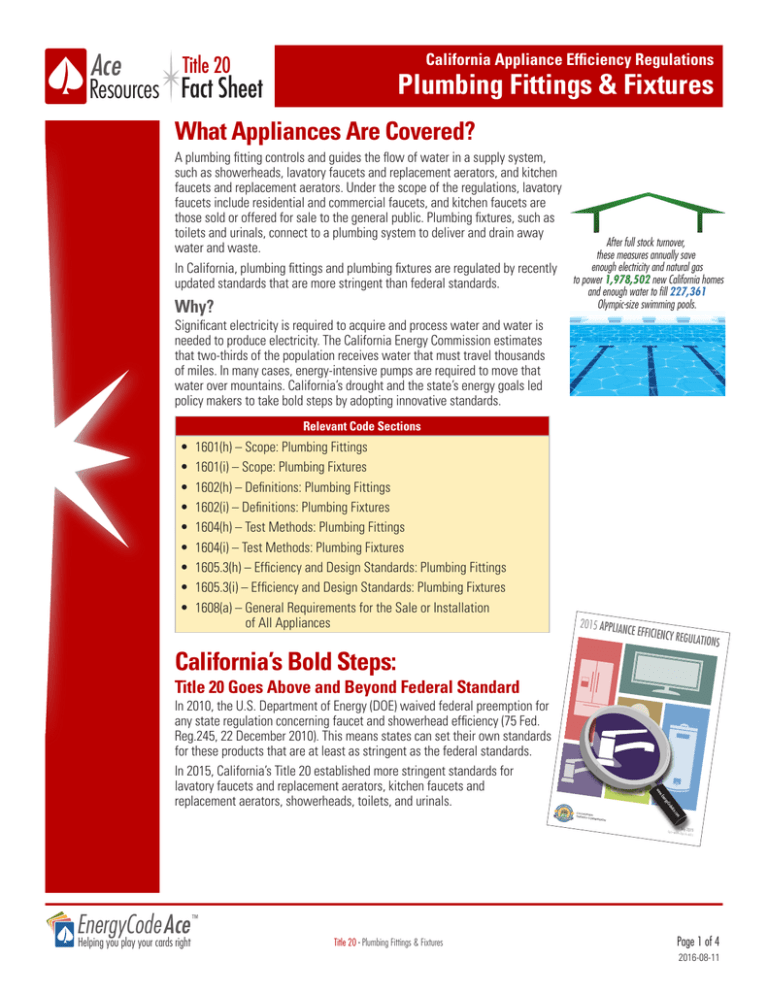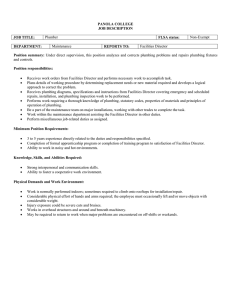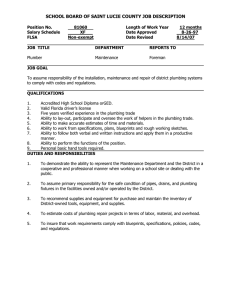
Ace
California Appliance Efficiency Regulations
Title 20
Plumbing Fittings & Fixtures
Resources Fact Sheet
What Appliances Are Covered?
A plumbing fitting controls and guides the flow of water in a supply system,
such as showerheads, lavatory faucets and replacement aerators, and kitchen
faucets and replacement aerators. Under the scope of the regulations, lavatory
faucets include residential and commercial faucets, and kitchen faucets are
those sold or offered for sale to the general public. Plumbing fixtures, such as
toilets and urinals, connect to a plumbing system to deliver and drain away
After full stock turnover,
water and waste.
these measures annually save
enough electricity and natural gas
In California, plumbing fittings and plumbing fixtures are regulated by recently
to power 1,978,502 new California homes
updated standards that are more stringent than federal standards.
and enough water to fill 227,361
Olympic-size swimming pools.
Why?
(each holding 660,430 gallons of water!)
Significant electricity is required to acquire and process water and water is
needed to produce electricity. The California Energy Commission estimates
that two-thirds of the population receives water that must travel thousands
of miles. In many cases, energy-intensive pumps are required to move that
water over mountains. California’s drought and the state’s energy goals led
policy makers to take bold steps by adopting innovative standards.
Relevant Code Sections
• 1601(h) – Scope: Plumbing Fittings
• 1601(i) – Scope: Plumbing Fixtures
• 1602(h) – Definitions: Plumbing Fittings
• 1602(i) – Definitions: Plumbing Fixtures
• 1604(h) – Test Methods: Plumbing Fittings
• 1604(i) – Test Methods: Plumbing Fixtures
• 1605.3(h) – Efficiency and Design Standards: Plumbing Fittings
• 1605.3(i) – Efficiency and Design Standards: Plumbing Fixtures
• 1608(a) – General Requirements for the Sale or Installation
of All Appliances
2015 APPLIA
NCE EFFICIEN
CY REGULATIO
California’s Bold Steps:
NS
Title 20 Goes Above and Beyond Federal Standard
ww
In 2010, the U.S. Department of Energy (DOE) waived federal preemption for
any state regulation concerning faucet and showerhead efficiency (75 Fed.
Reg.245, 22 December 2010). This means states can set their own standards
for these products that are at least as stringent as the federal standards.
In 2015, California’s Title 20 established more stringent standards for
lavatory faucets and replacement aerators, kitchen faucets and
replacement aerators, showerheads, toilets, and urinals.
n
w.E
erg
yCo
deA
ce.c
MISSIO
om
CALIFO
RNI
ENERGY A
COM
N
C E C– 4 0 0
EnergyCode Ace
Helping you play your cards right
July 2015
–2 0 15 – 0
21
™
Title 20 - Plumbing Fittings & Fixtures
Page 1 of 4
2016-08-11
Highlights of Recent Changes
• Lavatory faucets and aerators have a tiered standard with the more stringent 1.2 gpm
requirement in effect July 2016. Public lavatory faucets have a more stringent maximum
flow rate of 0.5 gpm.
• As of January 1, 2016, sell-through is prohibited for public lavatory
faucets and aerators, kitchen faucets and aerators, toilets, and urinals.
• Showerheads have a tiered standard and now have minimum flow rate requirements.
Body sprayers and handheld showerheads are included in the definition of a
showerhead.
• The total flow rate of showerheads with multiple nozzles must be less than or equal to
the maximum flow rate when any or all nozzles are in use at the same time.
Appliance
Noncompliant kitchen and
public lavatory faucets and
aerators may not be sold or
offered for sale on or after
January 1, 2016, regardless of
manufacture date.
{
Lavatory faucets and
aerators (including
residential and
commercial)
Maximum Flow Rate
Manufactured prior to 9/1/2015
2.2 gpm at 60 psi1,2
Manufactured on or after 9/1/2015 1.5 gpm at 60 psi1,2
and prior to 7/1/2016
Manufactured on or after 7/1/2016
1.2 gpm at 60 psi1,2
Public lavatory faucets Sold or offered for sale on or after
1/1/2016
and aerators
0.5 gpm at 60 psi
Kitchen faucets and
aerators
Sold or offered for sale on or after
1/1/2016
1.8 gpm with optional
temporary flow of
2.2 gpm at 60 psi
Manufactured on or after 1/1/1994
and prior to 7/1/2016
2.5 gpm at 80 psi
Manufactured on or after 7/1/2016
and prior to 7/1/2018
Manufactured on or after 7/1/2018
2.0 gpm at 80 psi3
Showerheads
1.8 gpm at 80 psi3
Sprayheads with independently-controlled orifices and manual controls. The maximum flow rate
of each orifice that manually turns on or off shall not exceed the maximum flow rate for a lavatory faucet.
2
Sprayheads with collectively-controlled orifices and manual controls. The maximum flow rate of
a sprayhead that manually turns on or off shall be the product of (a) the maximum flow rate for a lavatory
faucet and (b) the number of component lavatories (rim space of the lavatory in inches (millimeters)
divided by 20 inches (508 millimeters).
3
Maximum flow rate. The maximum flow rate shall be the highest value obtained through testing at a
flowing pressure of 80 ± 1 psi and shall not exceed the maximum flow rate in Title 20, Table H-5.
Minimum flow rate. The minimum flow rate, determined through testing at a flowing pressure of
20 ± 1 psi, shall not be less than 60 percent of the flow rate reported by the manufacturer pursuant to
Section 1606(a). The minimum flow rate determined through testing at flowing pressures of 45 and 80
± 1 psi shall not be less than 75 percent of the flow rate reported by the manufacturer pursuant to
Section 1606(a).
Showerheads with multiple nozzles. The total flow rate of showerheads with multiple nozzles must
be less than or equal to the maximum flow rate in Title 20, Table H-5 when any or all nozzles are in use at
the same time.
1
Table 1: Title 20 Standards for Plumbing Fittings
Appliance
Noncompliant toilets and
urinals may not be sold or
offered for sale on or after
January 1, 2016, regardless
of manufacture date.
{
All water closets (toilets)
Trough-type urinals
Wall mounted urinals
Other urinals
Maximum Gallons per Flush or Dual-flush Effective Flush Volume
Sold or offered for sale on or after January 1, 2016
1.281
Trough length (inches) 16
0.125
0.5
Water closets sold or offered for sale after January 1, 2016 shall pass the Waste Extraction Test (Section
7.10) of ASME A112.19.2.
1
Table 2: Title 20 Standards for Plumbing Fixtures
EnergyCodeAce.com
Title 20 - Plumbing Fittings & Fixtures
Page 2 of 4
Watt’s the Connection?
The Water-Energy Nexus
Research performed by the Energy Commission found that water and energy resources
are inextricably connected. Transportation and treatment of water, treatment and disposal
of wastewater, and the energy used to heat and consume water account for nearly 20%
of the total electricity and 30% of non-power plant related natural gas consumed in
California. Demand for water resources is expected to rise due to population growth and
as a result of climate change and stricter regulatory rules protecting water quality.
Water-related electricity use is 48 terawatt-hours (TWh) per year.
n Agricultural End-Use:
3%
n Agricultural Water Supply
and Treatment:
1%
n Residential, Commercial
and Industrial Water Use:
11%
n Residential, Commercial and Industrial
Water Supply and Treatment:
3%
n Wastewater Treatment:
1%
“The sustainability of water
and energy depends on
advancements in energy and
water efficiency technologies
and integrated water/energy
resource planning and
policy development.”
– Water Research Foundation
Source: energy.ca.gov/research/iaw/water.html
The Energy Commission Staff Report on the
Water-Energy Relationship states that:
As water demand grows, so grows energy demand. Since population growth drives
demand for both resources, water and energy demand are growing at about the
same rates and, importantly, in many of the same geographic areas. This dynamic
is exacerbated by the fact that Northern California has two-thirds of the state’s
precipitation while two-thirds of the population resides in Southern California. Water
demand and electricity demand are growing rapidly in many of the same parts of
the state stressing already constrained electricity delivery systems. When electric
infrastructure fails, water system reliability quickly plummets and threatens the public
health and safety. The state water plan concludes that the largest single new
supply available for meeting this expected growth in water demand over the
next 25 years is water use efficiency.
How to Comply with Title 20
Compliance with Title 20 entails:
• Designing, marking, and labeling products according to the regulations
• Testing regulated products using the required test methods and
• Certifying the product to the Energy Commission.
Note that even if a plumbing fixture or fitting meets all performance
requirements outlined in Title 20, it is illegal to sell a regulated product
in California if the model number is not listed in the Energy Commission’s
Modernized Appliance Efficiency Database System (MAEDBS).
Everyone in the sales chain – including manufacturers, distributors, retailers, contractors and importers – is responsible for
ensuring regulated products are listed in the MAEDBS.
EnergyCodeAce.com
Title 20 - Plumbing Fittings & Fixtures
Page 3 of 4
For More Information
Title 20 Primary Documents
• 2016 Title 20 Appliance Efficiency Regulations:
govt.westlaw.com/calregs/Browse/Home/California/CaliforniaCodeof
Regulations?guid=I8F8F3BC0D44E11DEA95CA4428EC25FA0&originationContext
=documenttoc&transitionType=Default&contextData=(sc.Default)
– Section 1602 (Definitions) provides clear, relevant definitions for regulated products.
Some examples include showerheads and body sprayers; lavatory and kitchen
faucets; and replacement aerators.
California Energy Commission Information & Services
• Appliances Hotline – (888) 838-1467 or outside California (916) 651-7100
• Questions may also be emailed to Appliances@energy.ca.gov
• California Appliance Efficiency Standards Site:
energy.ca.gov/appliances
• Modernized Appliance Efficiency Database (MAEDBS):
https://cacertappliances.energy.ca.gov/Login.aspx
• Excerpt of the Amended Water Appliance Regulations:
http://docketpublic.energy.ca.gov/PublicDocuments/15-AAER-07/
TN207358_20160115T121130_Water_Appliance_Amendments_to_the_Appliance_
Efficiency_Regulati.pdf
• Letter Regarding the Removal of Non-compliant Plumbing Fittings and Fixtures
energy.ca.gov/appliances/documents/bulletins/2015-12-30_Example_Notification_
Ltr_to_Remove_Non-Compliant_Plumbing_Fittings_and_Fixtures.pdf
• Industrial, Agriculture and Water Research: Water-Energy Nexus Focus Area:
energy.ca.gov/research/iaw/water.html
• California’s Water-Energy Relationship – CEC Staff Final Report:
energy.ca.gov/2005publications/CEC-700-2005-011/CEC-700-2005-011-SF.PDF
U.S. Department of Energy (DOE) Information & Services
• Appliance and Equipment Standards Program:
energy.gov/eere/buildings/appliance-and-equipment-standards-program
Additional Resources
• Water Research Foundation:
waterrf.org
– Resources and a knowledge portal on multiple areas of research focus, including
water-energy management
• Energy Code Ace:
EnergyCodeAce.com
– An online “one-stop-shop” providing free resources and training to help
appliance and building industry professionals decode and comply with Title 20 and
Title 24, Part 6. The site is administered by California’s investor-owned utilities.
Of special interest: Energy Code Ace offers a free Title 20 On-Demand Video
Training curriculum focused on the compliance and certification essentials industry
professionals need to know and understand.
energycodeace.com/content/title-20-training
Please register with the site and select a Title 20 industry role for your profile in
order to receive messages about additions to our Title 20 offerings!
This program is funded by California utility customers under the auspices of the California Public Utilities Commission and in support of the California Energy Commission. © 2016 Pacific Gas and Electric Company,
San Diego Gas and Electric, Southern California Gas Company and Southern California Edison. All rights reserved, except that this document may be used, copied, and distributed without modification. Neither PG&E,
Sempra, nor SCE — nor any of their employees makes any warranty, express of implied; or assumes any legal liability or responsibility for the accuracy, completeness or usefulness of any data, information, method,
product, policy or process disclosed in this document; or represents that its use will not infringe any privately-owned rights including, but not limited to patents, trademarks or copyrights.
EnergyCodeAce.com
Title 20 - Plumbing Fittings & Fixtures
Page 4 of 4


